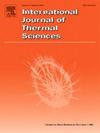Element mixing and solidification behavior during multi-track overlapping laser deposition of Cr-based alloys
IF 4.9
2区 工程技术
Q1 ENGINEERING, MECHANICAL
International Journal of Thermal Sciences
Pub Date : 2025-03-25
DOI:10.1016/j.ijthermalsci.2025.109890
引用次数: 0
Abstract
Multi-track overlapping laser deposition has been applied more widely than single track laser deposition in engineering practices. However, it is difficult to predict the solidification behavior and element mixing of multi-track overlapping laser deposition layers under existing conditions. Hence, in this paper, we not only derive the formula for calculating the arbitrary arc length of the overlapping cross-section, but also establish a three-dimensional multi-track overlapping laser deposition element mixing and solidification behavior prediction model. By the proposed model, the solidification behaviors of multi-track overlapping deposition layer and element concentrations of iron (Fe), nickel (Ni) and chromium (Cr) are predicted. The element redistribution and remelting solidification characteristics of the overlapping zone are further investigated. The results reveal that the element of Cr in the overlapping zone is 2 wt % higher than the first track non-overlapping zone. With the increase of deposition track, the concentrations of elements in the deposition layer tend to be uniform. The Pecletm number, convection time and mixing velocity of the melt pool in the track joint decrease significantly, but these values are still 1.5, 3.5 and 1.5 times higher than at the beginning (35 ms) of first track, respectively. Meanwhile, the change in crystal size and morphology of deposition layer is predicted according to cooling rate () and morphological parameters (G/R). The crystal size gradually increases from the top to the bottom of the deposition layer, and the morphology changes from equiaxed dendritic, columnar, and cellular crystals to planar crystals. In addition, the element distribution at the edge of multi-track overlapping laser deposition is uneven than in other regions.
cr基合金多道激光叠加沉积过程中元素混合及凝固行为
在工程实践中,多轨道叠加激光沉积比单轨道激光沉积应用更为广泛。然而,在现有条件下,难以预测多道激光叠加层的凝固行为和元素混合情况。因此,本文不仅推导了重叠截面任意弧长的计算公式,而且建立了三维多轨迹重叠激光沉积元件混合及凝固行为预测模型。利用该模型预测了多径重叠沉积层的凝固行为和铁(Fe)、镍(Ni)、铬(Cr)的元素浓度。进一步研究了叠合区的元素重分布和重熔凝固特性。结果表明,重叠区Cr元素含量比第一径道非重叠区高2 wt %。随着沉积径迹的增加,沉积层中元素的浓度趋于均匀。轨道接头内熔池的Pecletm数、对流时间和混合速度均显著减小,但仍比第一轨道开始时(35 ms)分别高1.5倍、3.5倍和1.5倍。同时,根据冷却速率(Gs∙Rs)和形貌参数(G/R)预测了沉积层晶粒尺寸和形貌的变化。从沉积层顶部到底部,晶体尺寸逐渐增大,形貌由等轴枝晶、柱状晶、胞状晶转变为平面晶。此外,多道叠加激光沉积边缘的元素分布比其他区域不均匀。
本文章由计算机程序翻译,如有差异,请以英文原文为准。
求助全文
约1分钟内获得全文
求助全文
来源期刊

International Journal of Thermal Sciences
工程技术-工程:机械
CiteScore
8.10
自引率
11.10%
发文量
531
审稿时长
55 days
期刊介绍:
The International Journal of Thermal Sciences is a journal devoted to the publication of fundamental studies on the physics of transfer processes in general, with an emphasis on thermal aspects and also applied research on various processes, energy systems and the environment. Articles are published in English and French, and are subject to peer review.
The fundamental subjects considered within the scope of the journal are:
* Heat and relevant mass transfer at all scales (nano, micro and macro) and in all types of material (heterogeneous, composites, biological,...) and fluid flow
* Forced, natural or mixed convection in reactive or non-reactive media
* Single or multi–phase fluid flow with or without phase change
* Near–and far–field radiative heat transfer
* Combined modes of heat transfer in complex systems (for example, plasmas, biological, geological,...)
* Multiscale modelling
The applied research topics include:
* Heat exchangers, heat pipes, cooling processes
* Transport phenomena taking place in industrial processes (chemical, food and agricultural, metallurgical, space and aeronautical, automobile industries)
* Nano–and micro–technology for energy, space, biosystems and devices
* Heat transport analysis in advanced systems
* Impact of energy–related processes on environment, and emerging energy systems
The study of thermophysical properties of materials and fluids, thermal measurement techniques, inverse methods, and the developments of experimental methods are within the scope of the International Journal of Thermal Sciences which also covers the modelling, and numerical methods applied to thermal transfer.
 求助内容:
求助内容: 应助结果提醒方式:
应助结果提醒方式:


